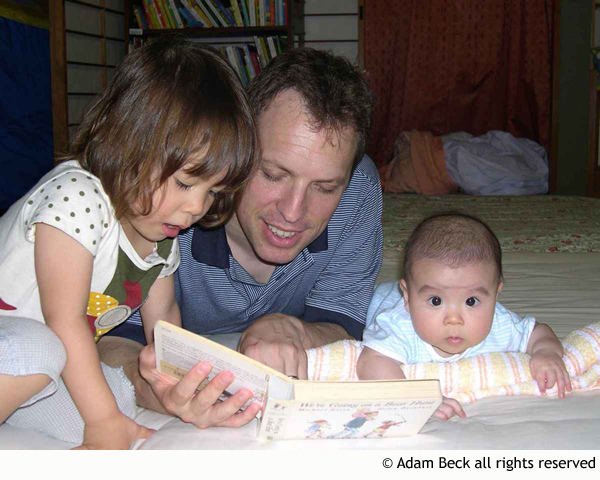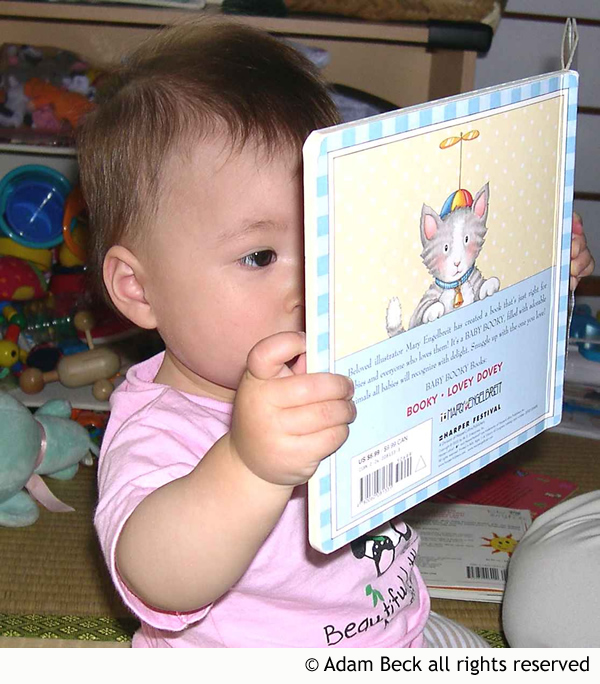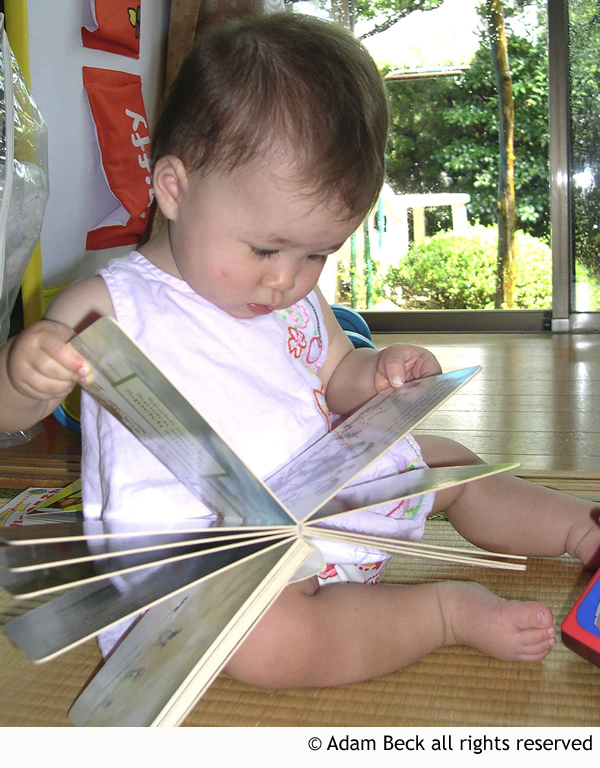 by guest blogger Adam Beck
by guest blogger Adam Beck
Though I no longer teach at Hiroshima International School, I return there every year, with my family in tow, for the school’s annual spring festival. For me, my main motivation—apart from seeing old friends—is the sale of used books: children’s books of all kinds, from the school library and students’ homes, at rock-bottom prices.
I practically start drooling as I paw through them.
Each year I come home with dozens of books for our home library: books I can read aloud to my kids at breakfast, books we read together for “shared reading” (taking turns, page by page), and books they can read on their own.
A couple of years ago, we came home from the festival and I dumped two heavy shopping bags of books on the kitchen table. I pulled out a chair and sat, happily examining my treasure and taping together the loose covers and pages. That’s when my daughter Lulu, then 9, approached and exclaimed, “Daddy, we have too many books!”
The truth is, if you stepped inside my little house, you’d probably laugh: It’s bursting with books, to the point where there really isn’t room for them all. Our bookshelves overflowed long ago and there are now piles rising from the floor like sunflowers.
But I turned to Lulu and I replied: “Too many books? You can never have too many books!”
My philosophy of education
“You can never have too many books!” These seven words basically sum up my view of language education since I first became a teacher of bilingual children 20 years ago. Books and reading—lots of books and lots of reading—became my main ally in nurturing language development.
During my time at Hiroshima International School, I flooded my classroom with books and read often to my students. And as I watched their English ability grow, I realized that this same approach would become the cornerstone of my efforts to one day raise bilingual children of my own. I would flood the house with books in the minority language and make reading a daily staple of my family’s lifestyle.

500 books
I have seen the rewarding results of this “method” in my own personal experience, but in fact, there is also prominent research which indicates that a correlation between the number of books in the home and a child’s language development and ability, as well as academic achievement and even career success, is evident in countries and languages around the world.
Pursued over a period of 20 years and published in 2010, the authors of the massive study Family scholarly culture and educational success: Books and schooling in 27 nations analyzed the lives of some 70,000 people in a range of countries. At the heart of their research was this key question: About how many books were in your family’s house when you were 14 years old? (Any books, not simply books for children.)
At the same time, they gathered background data on these participants, such as the parents’ level of education and occupation, and their own schooling and work.
What does this research reveal? It demonstrates—even given the parents’ level of education and occupation, as well as such factors as gender, class, nationality, political system, and gross national product—that the impact of books is the same throughout the world and throughout many generations: Children in families with a home library of 500 books or more experience significantly greater educational success. On average, these children pursue their education for 3.7 years longer than children in homes with few or no books.
As the authors themselves write: “We find that parents’ commitment to scholarly culture [which they define as “the way of life in homes where books are numerous, esteemed, read, and enjoyed”], manifest by a large home library, greatly enhances their children’s educational attainment. … Scholarly culture has a powerful impact on children’s education throughout the world, in rich nations and in poor, under communism and under capitalism, under good governments and bad, in the present generation and as far back in history as now living memory can take us. … A book-oriented home environment, we argue, endows children with tools that are directly useful in learning at school: vocabulary, information, comprehension skills, imagination, broad horizons of history and geography, familiarity with good writing, understanding of the importance of evidence in argument, and many others.”

Implications for parents
Although this study was concerned more broadly with books in the majority language of each nation, and success in schooling, there are important implications for parents seeking to support the minority language of their bilingual children. After all, success in schooling is a direct outgrowth of success in language development.
-
Build a home library of books in the minority language—the bigger, the better.
Even if you don’t own 500 books (both children’s books and books for adults count!), the more books you have, and the more you make use of those books by reading aloud to your children each day and reading together, the more your children’s language ability will grow.
And, as the study suggests, the language-related “tools” that your children will gain in the minority language will also be a source of support to them when attending school in the majority language. For example, the knowledge about the world that my kids have gleaned from our English books at home serves them well when studying similar topics in Japanese.
-
Create an environment of bookshelves and books, not simply digital readers and e-books.
One important reason I haven’t yet shifted much from “real books” to e-books is because real books, in my view, provide a richer environment for the senses. It’s true, we’re slowly getting buried in books here, but the fact that my kids are surrounded by them (and stumbling over them), day in and day out, makes books and reading a way of life.
With bookshelves, books are continuously on display and available for discovery; this just isn’t the case with e-books lurking inside a digital device. Don’t get me wrong, I’m not knocking e-books—they have many merits, not the least of which would be helping me dig out of my housekeeping dilemma. But, to me, they also run the risk of turning books from “public things” into “private things.”
For the sake of my children’s language development, I want our home environment to support my aims, and I think emphasizing books that are tangible and tactile, as “public things” always beckoning to the eye, is a more effective course during their formative years.
-
Keep in mind that, as these researchers contend, “a taste for books is largely inherited.”
Of course, our main goal involves supporting the minority language of our bilingual kids. But have you ever considered the fact that, in a way, the support you’re providing to your children today will also affect the language development of their kids, your future grandchildren? (Sorry to turn you into a grandparent so soon!)
The study on “scholarly culture” makes this very clear in exploring the question: Where do libraries come from—who acquires a large library? And the authors conclude that “Scholarly culture, and the taste for books that it brings, persists from generation to generation within families largely of its own accord, independent of education and class.”
In other words, if you build a large library of books in your home, your children probably will, too, when they’re adults! And if your children do, your grandchildren will do the same for their kids! And so it goes, generation after generation, a love of language and literacy—and stronger language development—handed down far after your time.
Adapted from the book Maximize Your Child’s Bilingual Ability: Ideas and inspiration for even greater success and joy raising bilingual kids by Adam Beck, founder of the blog Bilingual Monkeys and the forum The Bilingual Zoo. Adam has worked with hundreds of bilingual and multilingual children, from toddlers to teens, as both a classroom teacher and a private tutor. He now lends support to many more families, in all parts of the world, via his book, blog, and forum. He has lived in Hiroshima, Japan since 1996 and is raising two bilingual children in Japanese and English.
How many books do you have in your home library or classroom library? Could strengthening this library help strengthen the language development of your children or students? Please add your thoughts below.

I would love to do this, except that we are still in a phase of life where we are moving frequently (internationally), and the weight of carrying the books in our luggage or the price of constantly shipping them back and forth is just too much.